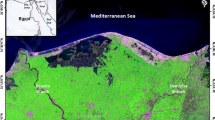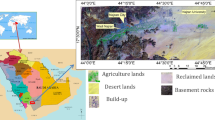Abstract
The northern coast of Oman (Al-Batinah plain), hosts the major population and irrigated agriculture of the country. Recently, it has experienced considerable land degradation, revealed by an inland shifting of cultivation. The main objective of this study was to assess the magnitude of land degradation in the past 2 decades (2001–2019) using the integration of remote sensing and geographical information system (GIS). The study relied on multi-temporal normalized difference vegetation index (NDVI), land surface temperature (LST), and surface albedo data linked with in situ groundwater salinity measurements. The degree of land degradation was determined by applying the geospatial weighted overlay analysis (WOA) combining both space-based and in situ data. Results showed that degraded lands account for almost 70% of the coastal zone, with 18.6% under severe degradation. Major degradation occurred at Barka and Shinas regions synchronized by significant groundwater salinization. Results of this study assert on the significance of geospatial modeling for mapping land degradation in arid regions.








Similar content being viewed by others
References
AbdelRahman M, Metwaly M, Shalaby A (2019) Quantitative assessment of soil saline degradation using remote sensing indices in Siwa Oasis. Rem Sens Appl Soc Environ 13:53–60
Ahmed I, Hussain N, Al-Rawahy S (2013) Management of saline lands in Oman: learning to live with salinity. In: Shahid SA et al (eds) Developments in soil salinity assessment and reclamation: innovative thinking and use of marginal soil and water resources in irrigated agriculture. Springer Science+Business Media, Dordrecht
Almazroui M (2020) Summer maximum temperature over the gulf cooperation council states in the twenty-first century: multimodel simulations overview. Arab J Geosci 13:477
Almazroui M, Islam MN, Saeed S, Saeed F, Ismail M (2020) Future changes in climate over the Arabian Peninsula based on CMIP6 multimodel simulations. Earth Syst Environ 4:611–630
Anyamba A, Tucker C (2012) Historical perspectives on AVHRR NDVI and vegetation drought monitoring. In: Wardlow BD, Anderson MC, Verdin JP (eds) Remote sensing of drought: innovative Monitoring Approaches NASA Publications, CRC Press/Taylor & Francis
Apaydin H, Sonmez F, Yildirim Y (2004) Spatial interpolation techniques for climate data in the GAP region in Turkey. Clim Change 28:31–40
Barrow CJ (1992) World atlas of desertification (United nations environment programme). Land Degrad Dev 3(4):249–249
Bezerraa F, Aguiara A, Alvalab R, Giarollaa A, Bezerraa K, Limac P, Nascimentod F, Araie E (2020) Analysis of areas undergoing desertification, using EVI2 multi-temporal data based on MODIS imagery as indicator. Ecol Ind 117:106579
Charabi Y, Al-Yahyai S (2013) Projection of future changes in rainfall and temperature patterns in Oman. J Earth Sci Clim Change 4:154
Chen W, Sakai T, Moriya K, Koyama L, Cao C (2013) Estimation of vegetation coverage in semi-arid sandy land based on multivariate statistical modeling using remote sensing data. Environ Model Assess 18:547–558
Clark WAV, Hosking PL (1986) Statistical methods for geographer. John Wiley & Son, Chisterter, p 518
Collins JB, Woodcock CE (1996) An assessment of several linear change detection techniques for mapping forest mortality using multi-temporal landsat TM data. Remote Sens Environ 56:66–77
Cui X, Gibbes C, Southworth J, Waylen P (2013) Using remote sensing to quantify vegetation change and ecological resilience in a semi-arid system. Land 2(2):108–130
Dai A (2011) Drought under global warming: a review. WIREs Clim Change 2:45–65
Deng Y, Wang S, Bai X, Tian Y, Wu L, Xiao J, Chen F, Qian Q (2018) Relationship among land surface temperature and LUCC, NDVI in typical karst area. Sci Rep 8:641
Eckert S, Hüsler F, Liniger H, Hodel E (2015) Trend analysis of MODIS NDVI time series for detecting land degradation and regeneration in Mongolia. J Arid Environ 113:16–28
El Kenawy AM, McCabe MF (2016) A multi-decadal assessment of the performance of gauge- and model-based rainfall products over Saudi Arabia: climatology, anomalies and trends. Int J Climatol 36:656–674
El Kenawy A, Al Buloshi A, Al-Awadhi T, Al Nasiri N, Navarro-Serrano F, Alhatrushi S, Robaa SM, Domínguez-Castro F, McCabe MF, Petra-Manuela S, Lopez-Moreno L, Vicente-Serrano SM (2020) Evidence for intensification of meteorological droughts in Oman over the past four decades. Atmos Res 246:105126
Ghebrezgabher M, Yang T, Yang X, Sereke T (2020) Assessment of NDVI variations in responses to climate change in the Horn of Africa. Egypt J Remote Sens Space Sci. https://doi.org/10.1016/j.ejrs.2020.08.003
Haselsteiner R (2011) Flood protection and groundwater recharge in the Batinah region in Oman. Interntaional Conference on Drought Management Strategies in Arid and Semi-Arid regions, Muscat, Oman, 11–14 Dec. 2011.
Hereher M (2014) The Lake Manzala of Egypt: an ambiguous future. Environ Earth Sci 72:1801–1809
Hereher M (2017) Effect of land use/cover change on land surface temperatures-The Nile Delta, Egypt. J Afr Earth Sci 126:75–83
Hereher M, Al-Buloshi A, Sherief Y, Al-Awadhi T, Al-Hatrushi S, Charabi Y (2020) Formation of the Wahiba Sand Sea in the Sultanate of Oman: implications of change in wind energy. Arab J Geosci 13(22):1–14
Hussain N, Al-Rawahy SA, Rabee J, Al-Amri M (2006) Causes, origin, genesis and extent of soil salinity in the Sultanate of Oman. Pak J Agric Sci 43(1–2):1–6
ICBA (2012) Oman salinity strategy. International Center for Biosaline Agriculture, Dubai, United Arab Emirates
Jackson TJ, Chen D, Cosh M, Li F, Anderson M, Walthall C, Doriaswamy P, Hunt E (2004) Vegetation water content mapping using Landsat data derived normalized difference water index for corn and soybeans. Remote Sens Environ 92(4):475–482
Jafari R, Bakhshandehmehr L (2016) Quantitative mapping and assessment of environmentally sensitive areas to desertification in central Iran. Land Degrad Dev 27:108–119
Jensen R (2004) Introductory digital image processing: a remote sensing perspective, 3rd edn. Prentice Hall, USA
Jensen R (2015) Introductory digital image processing: a remote sensing perspective, 4th edn. Pearson, USA
JICA (1990) The Study on A Master Plan for Agricultural Development, Final Report Vol. I and 2. Prepared by Japan International Cooperation Agency for the Sultanate of Oman.
Kamdar I, Ali A, Bennui A, Techato K (2019) Municipal solid waste landfill siting using an integrated GIS-AHP approach: a case study from Songkhla Thailand. Resour Conserv Recycl 149:220–235
Kapilan S, Elangovan K (2018) Potential landfill site selection for solid waste disposal using GIS and multi-criteria decision analysis (MCDA). J Cent South Univ 25:570–585
Köppen WP (1936) Das geographische system der klimate. Gebrüder Borntraeger, Berlin
Kwarteng AY, Dorvlo ASS, Kumar GT (2009) Analysis of a 27-year rainfall data (1977–2003) in the Sultanate of Oman. Int J Climatol 29:605–617
Lambin EF (1997) Modeling and monitoring land-cover change processes in tropical regions. Prog Phys Geog 21(3):375–393
Lamqadem A, Pradhan B, Saber H, Rahimi A (2018) Desertification sensitivity analysis using MEDALUS model and GIS: a case study of the oases of Middle Draa Valley. Morocco Sensors 18:2230
Li Z, Wang S, Song S, Wang Y, Musakwa W (2021) Detecting land degradation in Southern Africa using Time Series Segment and Residual Trend (TSS-RESTREND). J Arid Environ 184:104314
Loarie SR, Lobell DB, Asner G, Mu Q, Field C (2011) Direct impacts on local climate of sugar-cane expansion in Brazil. Nat Clim Chang 1(2):105–109
Lu D, Mausel P, Brondizio E, Moran E (2004) Change detection techniques. Int J Remote Sen 25(12):2365–2404
MAF (1993) South Batinah integrated study. Directorate General of Agricultural Research Ministry of Agriculture and Fisheries, Muscat, Oman
MAF (2010) Agriculture statistics. Ministry of Agriculture and Fisheries, Muscat Sultanate of Oman
Masoudi M, Jokar P, Pradham B (2018) A New Approach for land degradation and desertification assessment using geospatial techniques. Nat Hazards Earth Syst Sci Discuss 18:1–9
McDonnell, R. (2016) Groundwater use and policies in Oman. International Water Management Institute (IMWI) Project No. 14: Groundwater Governance in the Arab World, 68
MRMEWR (2005) National Action Programme to Combat Desertification in the Sultanate of Oman. Ministry of Regional Planning, Environment and Water Resources, Muscat, Sultanate of Oman
NASA (2009) Landsat 7 Science Data Users’ Handbook
The National Center for Statistics and Information (NCSI) (2009) The Statistical Year Book, Muscat, Oman. www.ncsi.gov.om. Accessed 30 Sept 2020
The National Center for Statistics and Information (NCSI) (2018) The Statistical Year Book, Muscat, Oman. www.ncsi.gov.om. Accessed 30 Sept 2020
Ozelkan E, Bagis S, Ozelkan E, Ustundag B, Yucel M, Ormeci C (2015) Spatial interpolation of climatic variables using land surface temperature and modified inverse distance weighting. Int J Rem Sen 36(4):1000–1025
Singh A (1989) Digital change detection techniques using remotely sensed data. Int J Rem Sen 10:989–1003
Sobrino JA, Franch B, Oltra-Carrio R, Vermote EF, Fedele E (2013) Evaluation of the MODIS albedo product over a heterogeneous agricultural area. Int J Remote Sens 34(15):5530–5540
Tomasella J, Silva PV, Barbosa RM, Rodriguez AA, de Oliveira DA, Sestini F (2018) Desertification trends in the Northeast of Brazil over the period 2000–2016. Int J Appl Earth Obs Geoinf 73:197–206
Tucker C (1979) Red and photographic infrared linear combination for monitoring green vegetation. Rem Sens Environ 8:127–150
United Nations (2011) Global drylands: A UN system-wide responses. United Nations Environment Management Group, UN
Wan Z, Zhang Y, Zhang Q, Li Z (2002) Validation of the land-surface temperature products retrieved from terra moderate resolution imaging spectroradiometer data. Rem Sens Environ 83(1–2):163–180
Wan Z, Hook S, Hulley G (2015) MYD11A2 MODIS/Aqua Land Surface Temperature/Emissivity 8-Day L3 Global 1km SIN Grid V006. NASA EOSDIS Land Processes DAAC. https://doi.org/10.5067/MODIS/MYD11A2.006
Wang J, Wei H, Cheng K, Ochir A, Davaasuren D, Li P, Chan F, Nasanbat E (2020) Spatio-temporal pattern of land degradation from 1990 to 2015 in Mongolia. Environ Dev 34:100497
Wilks DS (2011) Statistical methods in the atmospheric sciences. Elsevier Academic Press, Amsterdam, Boston (ISBN: 9780123850225 0123850223)
Yao Y, Qin Q, Ghulam A, Zhu L, Yang N (2008) Relating surface albedo and vegetation index with surface dryness using Landsat ETM+ imagery. Proceedings of the IEEE International Geoscience & Remote Sensing Symposium, IGARSS 2008, July 8–11, 2008, Boston, Massachusetts, USA,
Yuan F, Bauer ME (2007) Comparison of impervious surface area and normalized difference vegetation index as indicators of surface urban heat island effects in Landsat imagery. Int J Rem Sen Environ 106:375–386
Acknowledgements
The authors deeply acknowledge the help of the Ministry of Regional Municipalities and Water Resources for providing the groundwater data of the study area. We also thank the Land Processes Distributed Active Archive Center of NASA (LP DAAC) and the United States Geological Survey Earth Explorer Gateway for providing remotely sensed data. We also acknowledge the continuous support from the Geography Department, Sultan Qaboos University, Oman.
Author information
Authors and Affiliations
Corresponding author
Ethics declarations
Conflict of Interest
The author declares that no conflict of interest exists with any person or organization.
Rights and permissions
About this article
Cite this article
Hereher, M., El-Kenawy, A. Assessment of Land Degradation in Northern Oman Using Geospatial Techniques. Earth Syst Environ 6, 469–482 (2022). https://doi.org/10.1007/s41748-021-00216-7
Received:
Accepted:
Published:
Issue Date:
DOI: https://doi.org/10.1007/s41748-021-00216-7




